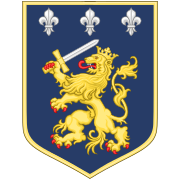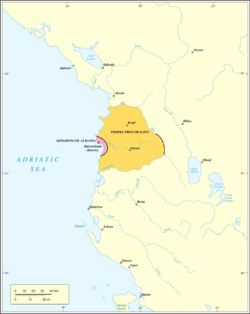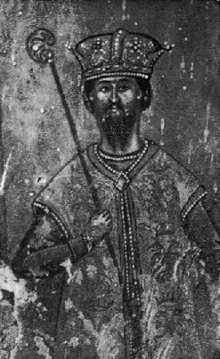Thopia family
Thopia family was one of the most powerful Albanian feudal families in the Late Middle Ages. It was initially part of the nobility of the Angevin Kingdom of Albania.
| Thopia Topia, Theopias, Thopias, Topias | |
|---|---|
| Noble house | |
 | |
| Founded | 1329 |
| Founder | Tanusio Thopia |
| Final ruler | Niketa Thopia |
| Titles | conte (count), lord |
| Estate(s) | Between rivers Mat and Shkumbin |
| Dissolution | after 1479 |
| Cadet branches | Toptani family |
Early history
The first mention of the Thopia is from 1329,[3] when Tanusio Thopia was mentioned as one of the counts of Albania.[4] In 1338, Tanusio was mentioned as Count of Matia (conte di Matia).[5] According to Anamali & Prifti, Tanusio had a brother, Dominik, who was a high cleric and served as a counsel of Robert of Anjou.[6]
According to Karl Hopf, Tanusio's son or brother Andrea, as told by Gjon Muzaka (fl. 1510), had fallen in love with the daughter of Robert of Naples when her ship, en route to the Principality of the Morea to be wed with the bailli, had stopped at Durazzo where they met. Andrea abducted and married her, and they had two sons, Karl and George. King Robert, enraged, under the pretext of reconciliation had the couple invited to Naples where he had them executed.[7]
The family converted from Eastern Orthodoxy to Catholicism.[8]
By 1340 the Thopia controlled much of the territory between the rivers Mati and Shkumbin rivers. Together with the Muzaka family, they agreed to recognize Angevin suzerainty after rebelling against the Serbs. However except for Andrea Muzaka who defeated the Serbs in a battle in the Peristeri mountains, no action was taken to realize the treaty with the Angevins.[9]
Karl Thopia

Under Karl Thopia the family reached its zenith. After the death of Emperor Stefan Dušan (1355), Karl managed to capture much of central Albania which was part of the Serbian Empire until then. In 1362 his forces attacked the city of Durrës, then in Angevin hands. Although he couldn't capture the city, he forced them to pay an annual tribute to his family. In 1368 Karl managed to capture the city of Durrës.[6] Around 1370 Karl attacked the dominions of the Muzaka family and managed to capture from them the territory between Shkumbin and Seman. Now the territory of Thopia extended from Mat river to Seman, reaching its maximum extension.[10] This aggressive behavior brought a complicated situation and many enemies. In 1376 Louis of Évreux, Duke of Durazzo who had gained the rights on the Albanian Kingdom from his second wife, attacked and conquered the city. However, in 1383, Karl Thopia took control of the city again.[11]
Muzaka family allied with Balša II against Thopia. In the beginning of 1385, the city of Durrës was captured by Balša II in a surprise attack. Karl called for Ottoman help and Balša's forces were defeated in the Battle of Savra. Thopia recaptured the city of Durrës the same year and held it until his death in 1388. Afterwards, the city of Durrës was inherited by his son Gjergj, Lord of Durrës. In 1392 Gjergj surrendered the city of Durrës and his domains to the Venice.[12]
After Karl

After the death of Karl, his dominion was divided between his daughter Helena Thopia and his son Gjergj Thopia. Gjergj kept the city of Durrës and his surroundings which he later surrendered to Venice Republic, while Helen Thopia kept the city of Krujë and its surroundings. She was married to Venetian nobleman Marco Barbarigo. The count Niketa Thopia, a cousin of Gjergj, ruled in the region south of Durrës. In 1403, Niketa Thopia managed to capture the city of Krujë from his cousin Helena, thus gaining another part of the territory previously held by Thopia. He had good relations with Venice which was interested in having some buffer zone between them and advancing Ottoman army. However, in 1412, Niketa Thopia suffered a heavy defeat from the forces of Teodor II Muzaka. He himself fell prisoner and with the intervention of Ragusan Republic he was released, but only after giving some territories around Shkumbin river to Muzaka family. Upon his death in 1415, the castle of Krujë fell to the Ottomans.[13]
Later representatives
Later well known representatives include Tanush Thopia a famous commander of Skanderbeg army and the commander of Krujë garrison during Second Siege of Krujë.
Members
- Tanusio, Count of Matia (1328–38), one son
- Andrea, married illegitimate daughter of Robert I of Naples, both were murdered by Robert, two sons
- Karl (or Carlo), married Vojislava Balšić, in c. 1370., three children. Karl had seven children in total
- George (fl. 1388–d. 1392), Lord of Durazzo, married Teodora Branković, no issue
- Helena (fl. 1388–1403), married Venetian count Marco Barbadigo (first marriage) and Serbian lord Konstantin Balšić (second marriage), one son with Konstantin Balšić
- Stefan Maramonte (fl. 1419-40), Zetan nobleman, married Vlajka Kastrioti
- Voislava, married N Cursachio (first marriage) and in 1394, Progon Dukagjini, Lord of Lezhë and uncle of Pal Dukagjini[14] (second marriage)
- Maria, unknown mother, married Filippo di Maramonte
- Niketa Thopia, unknown mother, married a daughter of Komnen Arianiti, one daughter
- Mara, married Balša III in 1407 (divorced by 1412), one daughter
- Jelena Thopia Balšić
- Mara, married Balša III in 1407 (divorced by 1412), one daughter
- Unknown (possibly George/Giorgio), no issue
- Andrea Thopia
- Unknown, one son
- Tanush Thopia, nephew of Andrea
- Karl (or Carlo), married Vojislava Balšić, in c. 1370., three children. Karl had seven children in total
- Andrea, married illegitimate daughter of Robert I of Naples, both were murdered by Robert, two sons
References
- Heraldika Shqiptare, Gjin Varfi, 2000, ISBN 9992731850 ISBN 978-9992731857
- Genc Myftiu. Albania, a patrimony of European values: a short encyclopedia of Albanian history and cultural heritage.
The emblem of his principality was a lion with Angevin lilies.
- Johann Georg von Hahn (1867). Reise durch die Gebiete des Drin und Wardar: im Auftrage der K. Akademie der Wissenschaften unternommen im Jahre 1863. Aus der Kaiserlich-Königlichen Hof- und Staatsdruckerei. p. 282.
- Émile G. Léonard (1932). Histoire de Jeanne 1re, reine de Naples, comtesse de Provence (1343-1382): La jeunesse de la reine Jeanne. Imprimerie de Monaco. p. 107.
- Bollettino della Badia Greca di Grottaferrata. Scuola Tipografica Italo-Orientale "S.Nilo". 1978.
- Anamali, Skënder and Prifti, Kristaq. Historia e popullit shqiptar në katër vëllime. Botimet Toena, 2002, ISBN 99927-1-622-3 p. 249
- Carl Hermann Friedrich Johann Hopf (1960). Geschichte Griechenlands vom Beginn des Mittelalters bis auf unsere Zeit. B. Franklin.
darauf in der Hand jenes Tanussio Thopia (1328 — 1338) waren, dem König Robert von Neapel 1338 den Besitz der Grafschaft Mal bestätigte. Des letztem Sohn oder Bruder Andreas war es, der sich mit dem Haufe Eapet verschwägerte. König Robert, so erzählt Musachi, hatte seine natürliche Tochter dem Bailli von Morea — vielleicht dem Bertrand de Baux — zur' Gattin bestimmt und sie nach Durazzo gesandt, wo damals Thopia weilte. Er verliebte sich in sie, entführte und heirathete sie. Zwei Söhne, Karl und Georg, ent« sprossen dieser Ehe. Aber schwer traf die Gatten bald die Rache des erzürnten Vaters; unter dem Scheine der Versöhnung lud er beide zu sich nach Neapel ein und ließ sie dort hinrichten; die Kinder aber, in denen somit wirtlich das Blut der Angiovlnen stoß, wurden gerettet; in der festen Burg Kroja , die er später ausbaute, nicht, wie die Sage meldet , erst gründete "), wuchs Karl auf, entschlossen, den Mord des vaters zu rächen
- Kristaq Prifti (1993). The Truth on Kosova. Encyclopaedia Publishing House. p. 52. Retrieved 5 January 2014.
... Tanush Thopia from a family which passed easily from Orthodoxy to Catholicism ...
- Fine, John V. A.; Fine, John Van Antwerp (1994-01-01). The Late Medieval Balkans: A Critical Survey from the Late Twelfth Century to the Ottoman Conquest. University of Michigan Press. p. 291. ISBN 0472082604.
- Anamali, Skënder and Prifti, Kristaq. Historia e popullit shqiptar në katër vëllime. Botimet Toena, 2002, ISBN 99927-1-622-3 p. 250
- Fine, John Van Antwerp (1994), The Late Medieval Balkans: A Critical Survey from the Late Twelfth Century to the Ottoman Conquest, University of Michigan Press, ISBN 978-0-472-08260-5 p. 384
- Men of empire: power and negotiation in Venice's maritime state Johns Hopkins University studies in historical and political science Men of Empire Men of Empire: Power and Negotiation in Venice's Maritime State, Monique O'Connell Author Monique O'Connell Edition illustrated Publisher JHU Press, 2009 ISBN 0-8018-9145-0, ISBN 978-0-8018-9145-8 p.23
- Anamali, Skënder and Prifti, Kristaq. Historia e popullit shqiptar në katër vëllime. Botimet Toena, 2002, ISBN 99927-1-622-3 p.251-252
- Akademia e Shkencave e Shqipërisë; K. Prifti; Xh. Gjeçovi; M. Korkuti; G. Shpuza; S. Anamali; K. Biçoku; F. Duka; S. Islami; S. Naçi; F. Prendi; S. Pulaha; P. Xhufi (2002). Historia e Popullit Shqiptar. Tirana, Albania: Toena. p. 309. ISBN 99927-1-622-3. Retrieved 2012-04-23.